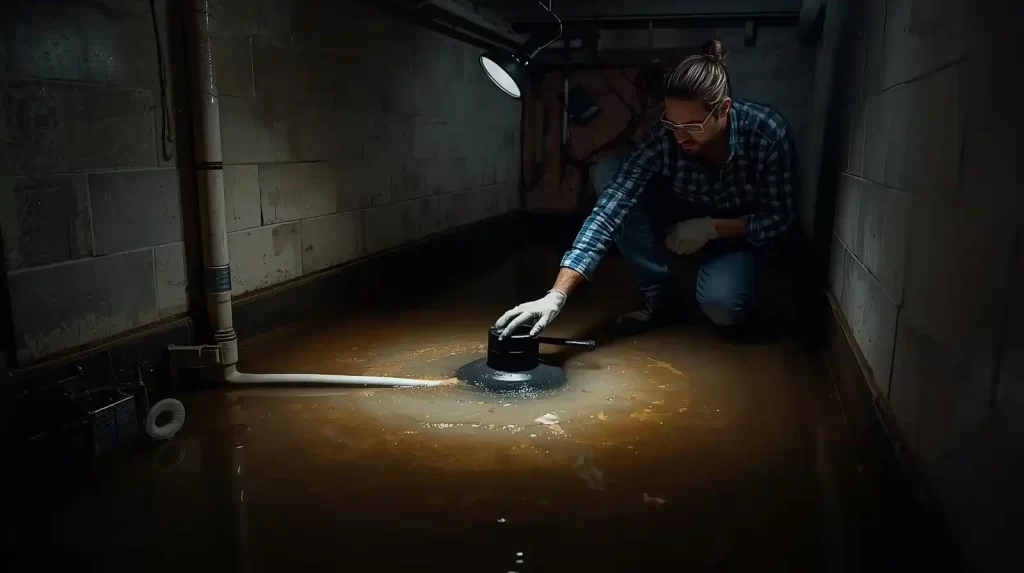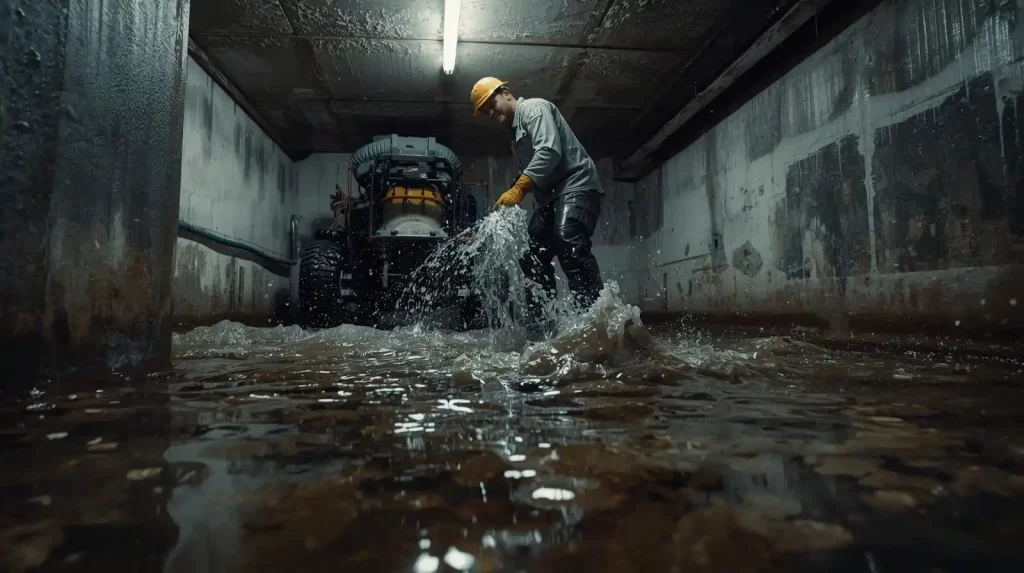Few things strike fear into a homeowner’s heart like discovering a flooded basement. Whether it happens during a heavy rainstorm, after a plumbing failure, or due to groundwater seepage, basement flooding can cause serious damage to your property. Left untreated, it can ruin furniture, compromise your foundation, and create a breeding ground for mold and mildew.
The good news? A sump pump can be the hero of the story. Installed in your basement or crawl space, this powerful device helps keep your home dry by pumping water away from your foundation before it causes damage. Let’s take a closer look at why sump pumps are so effective, how they work, and why partnering with experts like Semper Fi, Yuma’s premier water damage restoration company, can save you from long-term headaches.

What Is a Sump Pump?
A sump pump is a compact, electrically powered device that sits in a specially constructed pit (called a sump basin) at the lowest point of your basement or crawl space. Its job is simple but crucial: when water accumulates in the pit, the pump automatically activates and pushes the water away from your home, usually into a storm drain, dry well, or designated drainage area.
Think of it as a guardian standing watch at the lowest point of your house, ready to leap into action whenever rising water threatens to invade.
How Does a Sump Pump Work?
Most sump pumps rely on a float switch or pressure sensor that detects water levels. Here’s a step-by-step breakdown:
- Water enters the sump basin through drains or natural groundwater seepage.
- The float rises as water levels increase, triggering the pump.
- The pump activates, pushing water out of the basin through a discharge pipe.
- Water is expelled safely away from your home’s foundation.
This automatic process can move thousands of gallons of water per hour, making sump pumps an essential line of defense against flooding.
Why Every Homeowner in Yuma, AZ Should Consider a Sump Pump
While Yuma is known for its desert climate, basement flooding can still occur. Heavy rains, flash floods, and even plumbing malfunctions can leave homeowners dealing with unexpected water damage. A sump pump provides peace of mind by:
- Protecting your foundation – Water around your home’s base can lead to cracks and structural instability.
- Preventing mold growth – Standing water and dampness are perfect conditions for mold and mildew, which can impact air quality and your family’s health.
- Saving money on repairs – Restoration after a flood can be costly. A sump pump minimizes the risk of needing extensive repairs.
- Preserving belongings – Finished basements, furniture, and personal items can be destroyed by water exposure.
When to Call the Professionals
While a sump pump is an excellent preventive measure, sometimes flooding is unavoidable—especially if your pump fails, isn’t properly maintained, or is overwhelmed by extreme conditions. That’s when you need the experts.
For homeowners in Yuma, Semper Fi is the go-to water damage restoration company. Known for their quick response and thorough service, they specialize in:
- Emergency water extraction
- Drying and dehumidification
- Mold remediation
- Structural repair and restoration
Semper Fi understands the unique challenges of water damage in the desert southwest and brings years of expertise to ensure your home is restored quickly and effectively. Their team works around the clock to minimize damage and help you get back to normal life as soon as possible.
Maintenance Tips to Keep Your Sump Pump Reliable
Owning a sump pump isn’t a “set it and forget it” solution. Regular maintenance ensures it’s ready when disaster strikes. Here are a few simple steps:
- Test the pump regularly: Pour a bucket of water into the sump basin to ensure the float rises and activates the pump.
- Clean the basin: Remove debris or sediment that could clog the system.
- Inspect the discharge pipe: Make sure it’s free of obstructions and directs water away from your home.
- Consider a backup system: Battery-operated backup pumps are a lifesaver during power outages.
By keeping your sump pump in top condition, you’ll reduce the risk of costly water damage and gain peace of mind during Yuma’s storm season.

The Bottom Line
A flooded basement can be devastating, but it doesn’t have to spell disaster. Installing a sump pump is one of the smartest investments you can make to protect your home from water damage. And when flooding does occur, having a trusted restoration partner like Semper Fi in Yuma, AZ can make all the difference.
With their expertise, rapid response, and commitment to quality, Semper Fi ensures your home is safe, dry, and restored to its former condition. Don’t wait until water is rising in your basement—take action now to safeguard your property.
FAQ
1. What is the main purpose of a sump pump?
A sump pump is designed to keep your basement or crawl space dry by automatically removing water that collects in a sump basin. It pumps the water safely away from your home’s foundation, reducing the risk of flooding, mold, and structural damage.
2. Do I really need a sump pump in Yuma, AZ?
Yes! Even though Yuma has a desert climate, heavy rains, flash floods, and plumbing issues can still cause water intrusion. A sump pump gives you extra protection and peace of mind against unexpected flooding.
3. How often should I maintain or test my sump pump?
Experts recommend testing your sump pump at least once every 3–4 months by pouring a bucket of water into the basin. It’s also wise to schedule a professional inspection once a year to ensure everything is working properly.
4. What happens if my sump pump fails during a storm?
If your sump pump fails—whether due to a power outage, clog, or malfunction—your basement can flood quickly. That’s why many homeowners install a battery backup system. And if flooding occurs, call Semper Fi, Yuma’s top water damage restoration company, for emergency cleanup and restoration.
5. Can a sump pump prevent all basement flooding?
While sump pumps are highly effective, no system is 100% foolproof. Extreme weather, pump failure, or blocked discharge pipes can still lead to flooding. However, having a sump pump greatly reduces the risk and potential damage.
6. How long does a sump pump typically last?
Most sump pumps last about 7–10 years with proper maintenance. If your pump is older than that, it’s smart to consider a replacement before it fails.
7. What’s the difference between a pedestal and a submersible sump pump?
- Pedestal pumps sit above the basin and are easier to service but noisier.
- Submersible pumps sit inside the basin, run more quietly, and are generally more powerful.
Both are effective—your choice depends on budget and space.
8. Can a sump pump help with mold prevention?
Yes. By keeping your basement dry, a sump pump reduces the moisture that mold and mildew need to thrive. If mold has already started growing, professional remediation from Semper Fi in Yuma will be necessary.
9. What should I do immediately if my basement floods?
First, ensure safety by turning off electricity to the affected area if possible. Next, stop the water source if it’s plumbing-related. Then, contact Semper Fi right away. Their team provides 24/7 emergency water damage restoration to minimize damage and start drying your home immediately.
10. How much does it cost to install a sump pump?
The cost varies depending on pump type, installation complexity, and whether a sump basin needs to be created. On average, homeowners can expect to spend between $1,000–$3,000. While it’s an investment, it’s far cheaper than repairing major flood damage.


